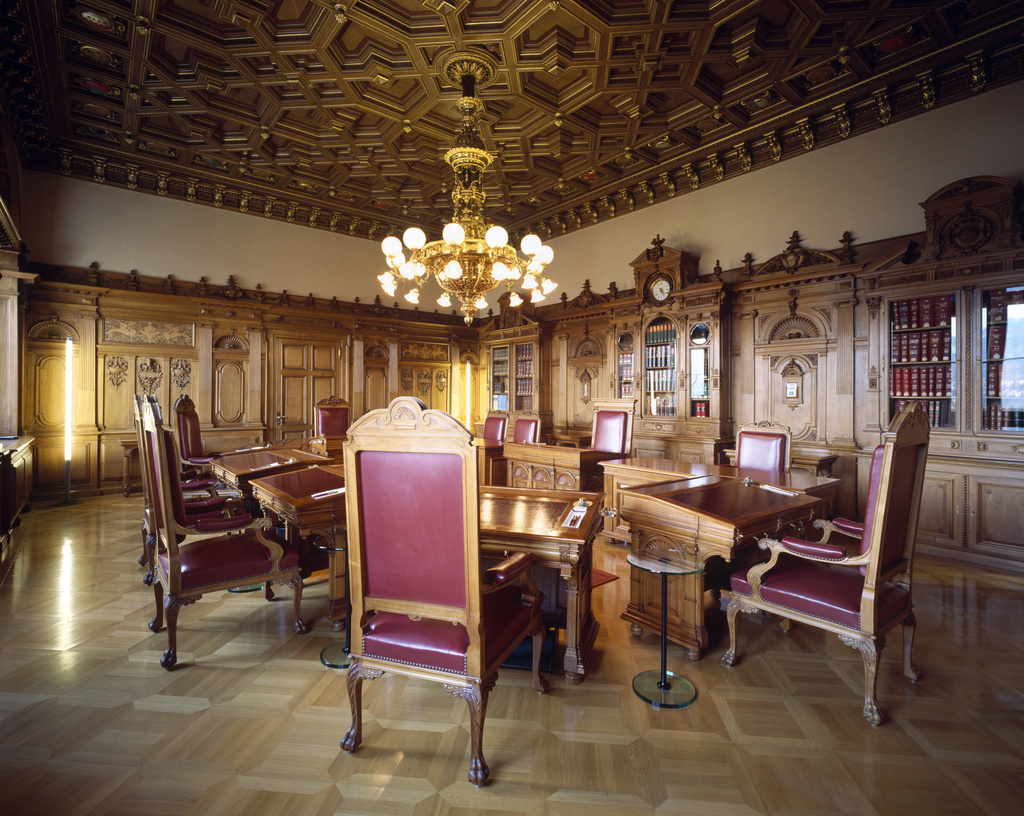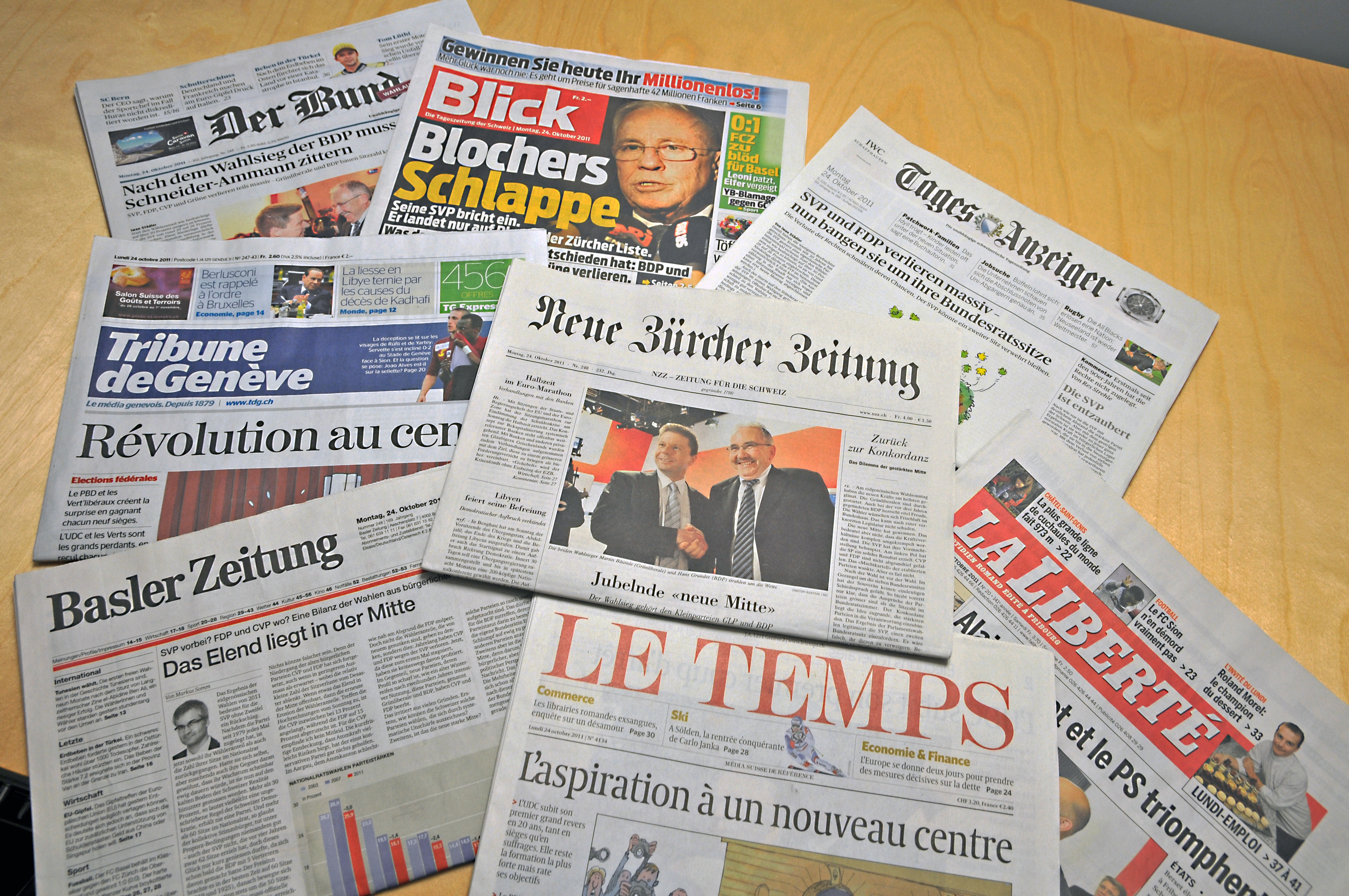Cabinet prepares for new round of musical chairs

Parliament is preparing to elect a new cabinet on December 14 amid great uncertainty over who will win the vacant seat and whether all incumbents will keep their posts.
Until a few years ago, the outcome was easy to predict: all ministers would be re-elected and any that were stepping down could be expected to be replaced with a candidate handpicked by their party since approval by parliament was largely a formality.
Between 1959 and 2003, the four largest parties divided the seven cabinet seats amongst themselves according to the so-called “magic formula”: two each to the centre-right Radicals, centre-right Christian Democrats and centre-left Social Democrats, and one to the rightwing Swiss People’s Party. This power sharing arrangement reflected Switzerland’s traditional political stability.
But the spectacular rise of the People’s Party, which saw it become the largest political group, put the magic formula in doubt. The first jolt to the system came in 2003 when the party gained a second cabinet seat with the election of Christoph Blocher – at the expense of the Christian Democrats.
Since then, no cabinet post has been secure. In 2007, parliament voted out Blocher, choosing instead a People’s Party colleague, Eveline Widmer-Schlumpf, even though she was not put forward as an official candidate by the party.
Disavowed by the rightwing group, Widmer-Schlumpf joined the Conservative Democrats, newly formed by members of the moderate wing of the People’s Party who supported her.
Winds of change
And this time round, various cabinet posts are up for grabs – a reflection of the winds of change that have swept over the political landscape in recent years.
After this turbulent, unprecedented period, the Swiss government for the first time consists of members from five parties.
The four biggest have not succeeded in coming up with a new formula, nor did the parliamentary elections on October 23 bring any clarity to how stability can be returned to the Swiss political system.
The big four all lost seats in the vote while two relatively new parties, the Conservative Democrats and Liberal Greens, gained ground.
It has been the People’s Party that has led calls for a new cabinet makeup. After rejecting Widmer-Schlumpf in 2007, the rightwing group now wants to claim her seat, which would give it two cabinet posts. But if parliament re-elects the finance minister, the People’s Party would have to target a seat currently belonging to another party.
The rightwing group has staked a claim to two seats based on simple arithmetic, in which the cabinet posts are distributed according to their percentage of the popular vote. In this case, the party’s 26.6 per cent would entitle it to the seat of the Conservative Democrats, which only won 5.4 per cent.
Centre-left alliance
The alliance of centre and leftwing parties that backed Widmer-Schlumpf’s election four years ago may withdraw their support this time around to stop the further ascension of the Conservative Democrats. The party would then be in danger of collapse if it lost its very popular minister.
This option has two other advantages for the left and the centre: the concession of a second seat to the People’s Party could force it to take more responsibility in governing the country, softening its hardline stance.
Recognition of the rightwing party’s claim to two posts would also make it easier for other cabinet ministers to hold onto their posts in future elections.
However, another plausible scenario would see Widmer-Schlumpf retain her place in government since the Christian Democrats, Social Democrats and Greens take similar positions to the Conservative Democrats on many issues. These include the free movement of people accord with the European Union and the rejection of nuclear energy.
The centre and left-leaning parties which control a majority of votes in parliament, could then block the path of the People’s Party. They are no longer afraid the rightwing group will go into opposition, as it did briefly and unsuccessfully in 2008 after the election of Widmer-Schlumpf.
And the party’s rise, which began in 1991, was halted in October’s parliamentary elections. It remains the largest single party but dropped 2.3 percentage points to 26.6 per cent.
Hard liners fail
In elections to the Senate, three of its hardline leaders, Christoph Blocher, Adrian Amstutz and Toni Brunner, failed to be chosen by voters to represent their cantons. Due to the poor results in both chambers, the People’s Party cannot count on much support on December 14.
Another possible scenario would see the Radicals as the big loser if Widmer-Schlumpf were to be re-elected. The Radicals may not be able to count on the support of the other centre and left parties if the People’s Party target one of its two seats.
In the past few years, the Radicals have become much more right leaning in the eyes of the Social Democrats and Greens. And their drop in the popular vote over the past 30 years has made it very difficult for the party – historically seen as representing the interests of the business community – to justify its cabinet seats.
The Christian Democrats and Conservative Democrats, which have begun discussions to form a bloc in parliament, together control nearly 18 per cent of the vote, versus 15 per cent for the Radicals.
Other outcomes cannot be excluded. There is also no guarantee that the seat to be vacated at the end of the year by Foreign Minister Micheline Calmy-Rey will go to a representative of her Social Democratic Party.
The only thing that is certain is that the cabinet elections on December 14 will be among the most dramatic of all time.
1959 – 2003
The longest period in which the “magic formula” was in effect: 2 seats each for the Social Democrats, Radicals and Christian Democrats and 1 for the Swiss People’s Party.
2004 – 2007
The People’s Party win a second seat (Christoph Blocher) at the expense of the Christian Democrats.
2008
Eveline Widmer-Schlumpf and Samuel Schmid leave the People’s Party to join the newly formed Conservative Democrats.
2009
In January, the People’s Party returns to the government when its candidate Ueli Maurer is elected by parliament to replace Samuel Schmid, who has decided to step down. In September, Didier Burkhalter from the Radicals wins parliament’s approval to take over the post of his party colleague, Interior Minister Pascal Couchepin.
2010
In September, Simonetta Sommaruga is elected to the cabinet to replace Social Democratic Party colleague, Moritz Leuenberger, while the Radicals’ Johann Schneider-Ammann is chosen to take over for Hans-Rudolf Merz of the same party.
2011
On December 14, both parliamentary chambers will be called on to choose a candidate to take over for resigning Foreign Minister Micheline Calmy-Rey of the Social Democrats, and to re-elect or find replacements for incumbents Doris Leuthard (Christian Democrats), Ueli Maurer (People’s Party), Eveline Widmer-Schlumpf (Conservative Democrats), Simonetta Sommaruga (Social Democrats), Didier Burkhalter and Johann Schneider-Ammann (Radicals).
(Adapted from Italian by Dale Bechtel)

In compliance with the JTI standards
More: SWI swissinfo.ch certified by the Journalism Trust Initiative















You can find an overview of ongoing debates with our journalists here . Please join us!
If you want to start a conversation about a topic raised in this article or want to report factual errors, email us at english@swissinfo.ch.